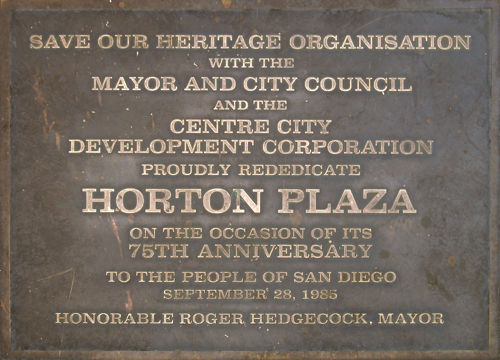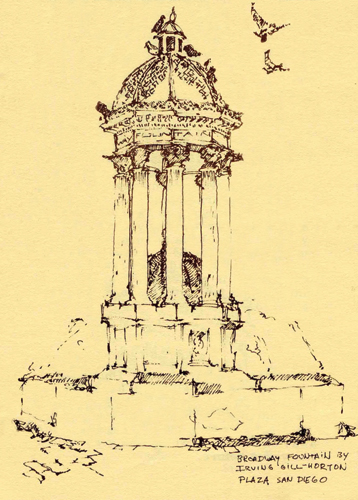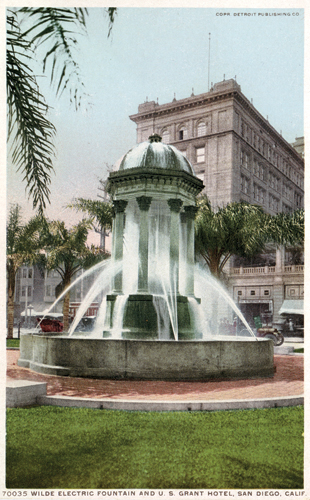|
The Broadway Fountain
How it came to be SOHO's logo
By Alana Coons

Rededication plaque honoring SOHO's preservation of the fountain and the 75th anniversary of the Plaza, 1985.
|

Sketch of the fountain by SOHO founder Robert Miles Parker from Reflections, December, 1975.
|

Postcard of Broadway Fountain, circa 1909.
|
Ever wonder what the story behind the SOHO logo is? How and why the Broadway fountain became the symbol for historic preservation in San Diego?
Alonzo Horton gave Horton Plaza to the city in 1870. Various changes were made to the plaza through the decades and in 1908, architect Irving J. Gill was hired to redesign it. According to Historian Richard W. Amero, "Gill's job was to make the plaza respectable, to find places for a fountain and a kiosk containing weather-reporting instruments, and to lay out walkways. The principal requirement was that the fountain be equipped with an electrical apparatus that would project blended colors on spraying water."
Sculptor Felix Peano designed the bronze eagle finial and three panels, and on the frieze above the columns is proclaimed, "Broadway Fountain for the People."
Gill's design was the winner of a design competition along with twelve other entries. It was a beautiful design that was well received by the community be all accounts, however, as early as 1913 innumerable plans began to be presented to redesign the plaza and fountain. During WWII it was suggested to take out the palms, grass, walks, and chains and turn the plaza into a bus depot for war workers. While this idea was opposed by city parks in 1943 the city still widened sidewalks on all sides, removed the grass, and laid asphalt around information booths and trees.
After the war the Park Commission wanted to remove wartime encroachments and incorporate a closed-off Plaza Street into the plaza, the plan that called for the elimination of fountain, palms, cannon, and markers. This and many other subsequent plans were not approved.
Meanwhile the condition and maintenance of the plaza was never addressed as the focus was on how to remove or alter it. By 1955 the deteriorated condition could no longer be ignored and the Chamber of Commerce requested once again the removal of fountain, palms and grass. Heated letters were printed in local papers from readers who wanted the plaza they knew put in good condition and did not want it destroyed. Siding with its citizens the Council voted to clean the plaza and renovate.
From its inception the plaza had problems related to vagrancy but it still continued to be a prominent location for important speeches, proclamations and special events. Many city celebrations took place in the plaza; some of you were probably there when Vice President Richard Nixon and Senator John F. Kennedy held rallies at the plaza in support of their presidential candidacies.
In 1961 Architect C.J. Paderewski presented his plan for the plaza. Like others before him, he would remove the fountain, but took one step further and explained to the unenlightened that the fountain had "no historical significance." Calling for a rectilinear, off-center plaza, with a sunken fountain, deciduous trees around the perimeter instead of palms, benches underneath the trees, a row of flags, covered areas, a new information booth, and colored paving. In order for his design and plan to be effective he called for "property owners on adjacent streets to alter facades to create a unified effect." Just envision that for a moment. The City did not consider the horrendous proposal.
Talk of a high-rise federal building south of the plaza began and C. Arnolt Smith urged that a plaza be built on the north side of Broadway as a frontage for the Community Concourse.
By 1964, the Downtown Association urged the City to proceed with the Paderewski plan; great protest from citizens was published in the San Diego Union and once again the design was not approved.
In 1965 architects Frank L. Hope and Samuel Hamill issued their plan for downtown and the redevelopment of Horton Plaza, and in 1966, the Downtown Association joined with the San Diego Chapter of the AIA (SDAIA) to produce yet another plan for Horton Plaza.
And on and on it went until 1969-70 when a task force was appointed to improve a twelve-block area. This is when SOHO first got involved working behind the scenes with city staff and in 1971 the Plaza was designated as Historic Site No. 51.
In 1973, the Centre City Development Corporation was created. Developer Ernest Hahn was contracted to build a shopping center extending from E to G Streets. Hahn endorsed the expansion of the plaza to E Street. His thought was that a larger plaza could hold a small amphitheater in one corner and a small building in the center. At this time City staff nominated Horton Plaza for listing in the National Register of Historic Places, but under great pressure they were forced to withdraw the nomination.
Hahn, with architect Frank Hope, gave our city this plan as outlined in SOHO's 1975 Reflections article by Bruce Kamerling: "The plan anticipates complete demolition of nine blocks in the heart of the city and replacement of existing structures by a mammoth Park and Shop complex. Set for destruction is a distinguished array of buildings associated with the downtown area's unique identity and heritage, including the Horton Grand Hotel, the Balboa Theater and the Spreckles building, all historic city landmarks." Hope recommended that the Spreckles be "temporarily preserved subject to later demolition and replacement by hotel expansion or a major office facility." With this mindset Hope and other like-minded architects submitted more plans, each more egregious then the last.
By 1977 the City Council approved changes that would desecrate the plaza and fountain. SOHO, buoyed by the recent win in saving the Santa Fe Depot from demolition, went into action galvanizing the community around saving the plaza and fountain, and by these actions in effect securing the protection of many historic buildings around it. The City Council showing great forethought and wisdom turned their decision around and instead agreed to restore the plaza to its 1910 appearance. This plan would cost $550,000 instead of the $1.8 million required by the most recent plan and with public outcry so high and being sensitive to the need for economy, the Centre City Development Corporation also reversed its position.
This was a dramatic and hard won victory for SOHO and on March 11, 1985, rehabilitation work began. Mayor Hedgecock presented a commemorative plaque to representatives of SOHO at a ceremony at the plaza. The plaque reads: Save Our Heritage Organisation with the Mayor and City Council and the Center City Development Corporation proudly rededicate Horton Plaza on the occasion of its 75th anniversary to the people of San Diego, September 28, 1985, Honorable Roger Hedgecock, Mayor.
Today the fountain is in need of a complete and accurate restoration and the National Register listing should once again be pursued by the City whose charge is in caring for its cultural landmarks.
So that's the very condensed story of how and why the Broadway Fountain became the SOHO's logo. It symbolizes our perseverance and our commitment to future generations; it recalls and illustrates the need to see beyond current trends, that while plans come and go, it is the things that represent our heritage, the things that remain classic and timeless that best illustrate who we are as a city and make us all the richer for it. With each succeeding year of saving our heritage the meaning of this symbol has only grown stronger. |
MORE FROM THIS ISSUE
The Broadway Fountain
San Diego's Historic Warehouse District
Just the Facts
National City & Otay Railroad Depot
The Inside Story
2007 Most Endangered List
Sim Bruce Richards
2007 People In Preservation Award Winners
Baseball Returns Downtown
Reflections
Lost San Diego
Strength in Numbers
Advertisements
DOWNLOAD full magazine as pdf (24mb)
|






